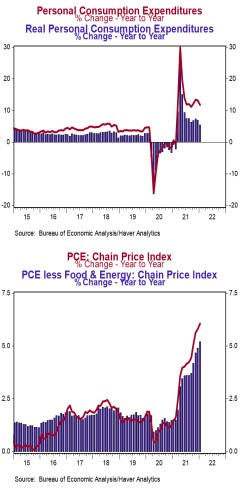- Personal income was unchanged in January (+0.3% including revisions to prior months), beating the consensus expected decline of 0.3%. Personal consumption rose 2.1% in January (+1.9% including prior months' revisions), beating the consensus expected +1.6%. Personal income is down 2.1% in the past year, while spending has increased 11.8%.
- Disposable personal income (income after taxes) increased 0.1% in January but is down 4.4% from a year ago.
- The overall PCE deflator (consumer prices) rose 0.6% in January and is up 6.1% versus a year ago. The “core” PCE deflator, which excludes food and energy, rose 0.5% in January and is up 5.2% in the past year.
- After adjusting for inflation, “real” consumption rose 1.5% in January, and is up 5.4% from a year ago.
Implications:
Incomes were unchanged in January, but consumers continued to increase spending, with the 2.1% jump in personal consumption representing the largest single-month increase since the last set of stimulus checks hit back in March 2021. Speaking of stimulus checks, comparisons to a year ago are muddied by the stimulus payments that hit accounts in January of last year, as well, which led to a temporary jump in both incomes and consumption (this problem will repeat itself come March). Compared to January of 2021, personal income is down 2.1%, while consumption is still up a strong 11.8%. Looking past the stimulus checks, private sector wages and salaries – a far more important (and sustainable) source of income than government transfer payments – rose 0.5% in January are up 11.2% from a year ago. It is progress on this front that will support consumer activity throughout 2022. On the spending side, the rise in activity was focused toward purchases of goods in January, not surprising given that Omicron cases and unusually cold winter weather led many to stay indoors. Since bottoming in April of 2020, consumption has grown at an astronomical 20.3% annualized rate, and spending today stands 12.4% above February 2020 levels. But artificially booming demand, the result of government transfers and rapid growth in the M2 money supply, is not without cost. PCE prices, the Fed’s preferred measure of inflation, rose 0.6% in January, and are up 6.1% from a year ago. Core prices, which exclude food and energy, rose 0.5% in January and are up 5.2% from a year ago. By either measure, prices are high, and rising. And the geopolitical conflict in Ukraine isn’t going to help ease inflation pressure in the short term. It is on the Fed to act swiftly and decisively in raising rates to reel in the inflation threat looming large over the U.S. economy.





